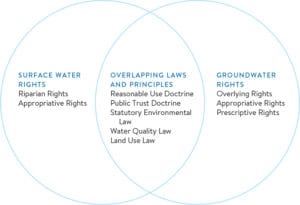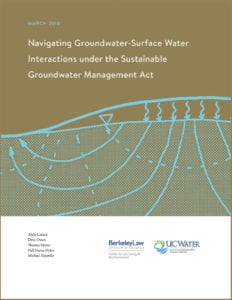March 2018
California’s Sustainable Groundwater Management Act (SGMA), passed in 2014, recognizes and addresses connections between surface water and groundwater. The statute is California’s first statewide law to explicitly reflect the fact that surface water and groundwater are frequently interconnected and that groundwater management can impact groundwater-dependent ecosystems, surface water flows, and the beneficial uses of those flows. As such, SGMA partially remedies the historically problematic practice of treating groundwater and surface water as legally distinct resources.
SGMA requires groundwater sustainability agencies (GSAs) to manage groundwater to avoid six undesirable results, including significant and unreasonable adverse impacts on beneficial uses of surface water. While this aspect of SGMA is clearly important, significant uncertainties exist regarding how GSAs will actually define and achieve this goal.
Addressing SGMA’s requirements for groundwater-surface water interactions will be difficult. Defining the issues at stake in any given basin, let alone successfully balancing the range of uncertainties and potentially conflicting interests, will pose challenges for many GSAs. No clear, pre-defined line exists to guide GSAs in determining what significant and unreasonable depletions of interconnected surface water will be, or whether their planned actions will sufficiently avoid them. Yet they are required to do so. Many GSAs will face pressure to aggressively address impacts on surface water in their basin. Many will face equal or greater pressure to draw the line more loosely. Nevertheless, it will fall to the GSAs to make a determination, and to defend it in their groundwater sustainability plans. Therefore, GSAs will likely take on some level of risk—either of successful legal challenges to their Groundwater Sustainability Plan (GSP), or of successful political opposition to the GSP, or of the GSP performing ineffectively, or of all these outcomes. Given the aggressive timeline inherent to SGMA, addressing this risk early will be crucial for preserving management options.
Challenges and risk are not the whole story, however. The process of addressing groundwater-surface water interactions also offers GSAs an opportunity to help communities and other stakeholders resolve, or avoid, difficult conflicts, and to do so in lasting ways. While California law has only recently begun to seriously address conflicts between surface and groundwater uses, those conflicts have been occurring for decades, and in some places for over a century. SGMA, in other words, did not create conflict between groundwater pumping and beneficial uses of surface water; it just created an opportunity—as well as an obligation—to respond to those challenges. Embracing that opportunity will not be easy, but GSAs that take SGMA as an opportunity to resolve longstanding issues can do lasting good.
 The research presented here examines some of the legal and institutional questions that will inevitably arise as GSAs seek to address groundwater-surface water interactions under SGMA. The core goal of this report is to help parties identify and address these questions, and ultimately to let GSAs and stakeholders manage groundwater-surface water interactions proactively and effectively.
The research presented here examines some of the legal and institutional questions that will inevitably arise as GSAs seek to address groundwater-surface water interactions under SGMA. The core goal of this report is to help parties identify and address these questions, and ultimately to let GSAs and stakeholders manage groundwater-surface water interactions proactively and effectively.
Download the Report:
Navigating Groundwater-Surface Water Interactions under the Sustainable Groundwater Management Act (Mar 2018)
See our op-ed in The Mercury News:
State law recognizes rivers and groundwater are connected — now what? (May 9, 2018)
See our Q&A in Water Deeply:
To Manage California’s Groundwater, Think More About Surface Water (May 1, 2018)
Read our paper in Environmental Research Letters:
California groundwater management, science-policy interfaces, and the legacies of artificial legal distinctions (April 2019)
For More Information:
Contact Mike Kiparsky, Director, Wheeler Water Institute, Center for Law, Energy & the Environment
This project is part of the UC Water Security and Sustainability Initiative supported by the University of California Office of the President
